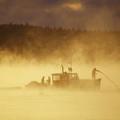Wherries and Swallows and Amazons
 A Penobscot Wherry is a good boat to land on a beach because of its flat bottom. Note the care taken in the spacing of the lapstrake planking. Photo courtesy Cottrell Boatbuilding
A Penobscot Wherry is a good boat to land on a beach because of its flat bottom. Note the care taken in the spacing of the lapstrake planking. Photo courtesy Cottrell Boatbuilding
I’ve been a saltwater sailor and racer all my life, but as years accrued and my body tired, I began to forego sailboat regattas. My lovely Luders 16 Ludicrous languished on her mooring while my wife and I sought out Maine’s inland waters. That involved photography, soaking in warm ponds, or chilling in clear streams and waterfalls.
But I hated being shore bound. Whenever we found ourselves on the bank of a pond or lake, I suffered an urge to get out there in a boat. Freshwater fantasies compelled me to install a trailer hitch on the old white Volvo. That car was only $1,900 and the hitch a mere 100 bucks from Rock Auto. But the part missing—some kind of lake boat—I suspected might drastically disrupt such frugality.
After some years, I came to know precisely what I wished for: a Penobscot headwaters lapstrake wherry. The only dilemma was whether to expend a year finding a plan and building my own, or to choose between a plank-on-frame model built by Walt Simmons at Duck Trap Woodworking in Lincolnville or a glued-lap plywood boat from Cottrell Boatbuilding in Searsport.
A few years back I helped a friend from Las Vegas acquire a Simmons Newfoundland Trap Skiff with a cat-ketch sailing rig. Between visiting Simmons’s shop, buying his book (the best ever written about wherries), and doing my journalistic homework, I came to appreciate the attributes of this kind of rowboat called a wherry.
The type’s name comes from “whirry,” an ancient word first appearing in the Coverdale Bible in 1455. It refers to a fishing boat out of which “maryners upon the see shall leape out of their boates, and set them selves upon the loade.”
 Seth Cottrell uses a heat gun to scrape excess glue from between the seams of plywood strakes used to build the hull. Photo by Mark Pillsbury
Seth Cottrell uses a heat gun to scrape excess glue from between the seams of plywood strakes used to build the hull. Photo by Mark Pillsbury
In the present day “whirry” has become “wherry”, and it refers to an open boat propelled by oars, used sometimes for fishing, but also for passengers, or just pleasure rowing. The distinctive feature of the wherry is that instead of a vertical keel with or without a keelson, a wherry is built up from a narrow, flat floor. The remainder of the boat has curves compounded upon curves, rounded sides, and a transom top that’s often the highest part of the hull. The thick flat bottom provides a shape perfect for hauling up onto a stony beach—or a boat trailer.
The Trap Skiff Simmons built had a sprit-rig, two-masted sail plan that he designed himself. But on his Rhodes and Duck Trap wherries, I noticed that the sailing rigs were designed by a naval architect, Richard M. Lagner, who had a cottage at Bayside, where salmon were caught in pound nets at the end of weirs for a century. Many of West Penobscot Bay’s “saltwater farmers” spent spawning time, “as maryners, who leap-ed out of whirries upon the loade of fish and hauled them in great numbers upon the shoare” as they might say in Coverdale Bible vernacular.
Langer, the yacht designer Simmons relied on, worked several years for Bill Luders (who designed my Ludicrous) and later for Sparkman and Stephens in New York. He also designed the beautiful Penobscot Wherry built by Cottrell Boatbuilding that had so caught my eye.
As part of doing my homework, I had the pleasure of hosting Art and Sandy Hall, of Belfast, in my living room. The Halls own the first Penobscot Wherry ever built by Dale Cottrell. Art also loves marine paintings and builds amazing half hull models, so it was a long and pleasant soiree. And, Sandy is Dick Lagner’s daughter. Her dad passed away two years ago, but through her I got to ask and learn about his background and the performance characteristics of the finished boat.
Sandy described her father as a modest and quiet yacht designer (isn’t that an oxymoron?) who was “raised on Swallows and Amazons,” the Arthur Ransome children’s storybooks about nautical adventures in the Lakes District of England. Lagner was nuts about boats from childhood and became a Webb Institute graduate. He participated in the heyday of classic boat design and had a hand in a great many sailing yachts you’d likely know the names of.
Lagner first discovered Penobscot Bay as a youngster at a sailing school at Bayside. Half a lifetime later he concluded that he loved Maine even more than the big-time at Sparkman and Stephens. So, he moved his family from Darien, Connecticut, to Woolwich, Maine, and never once regretted it. He worked at Hyde Windlass and later as manager of Hodgdon Yachts in East Boothbay. Lagner retired and spent more time at Sandy’s grand-dad’s Methodist Camp cottage at Bayside, where he designed several boats. He became interested in that region’s maritime history and, especially, its salmon wherries.
I wrote about the Newfoundland Trap Skiff in the March/April 2021 edition of MBH&H (Issue 169) and featured a Cottrell Whitehall pulling boat in the June 2022 issue. I recall that on my last visit with Walt Simmons—with my own interests in mind—I inquired into his opinions on a smaller wherry, much lighter, for my wife and me. It’s been a while, but I think he said he preferred building a much heavier and more rugged boat with solid wood, and felt that they performed better, especially sailing in coastal waters. Reading his book again recently, he said customers (like me) were always asking for lighter weight, which argues for thin and unbreakable plywood.
All this time I assumed I’d build a boat myself when the time came, and I agreed with Simmons in disliking stitch-and-glue plywood construction.
But my wife and I can only handle so much, and the Volvo shows her age in the up-country hills. For those reasons, the Cottrell’s method of glued-lapped plywood began to sound great to me. Besides, the last I spoke with Simmons he hinted he’d about-got-done building boats and wanted more gunsmithing and duck decoy jobs. He noted that premium wood is expensive and hard to move around and his back is, well, like my back.
The Cottrell family has eight or nine different skiffs and rowboats they build, all of them beautiful and lake-worthy. They are built as glued-lap plywood, which produces a lightweight, seamless boat that is very easy to maintain outside and inside, since it has no ribs or frames. Other than those benefits it is only for picky reasons that I’d choose the Penobscot Wherry above their several other models. I think by repeating some data Lynn Cottrell—Mother Hen of the company—came up with, I can explain how I came to slightly prefer this model.
The Penobscot Wherry entered the scene when Charlie Dhyse landed in Northport and started “Maine Coast Boathouse” on Route One. This was a landlocked boatyard and used-boat emporium dedicated exclusively to wooden boats. Dhyse continually located extremely desirable wood sailboats. His dooryard was packed with them. He went to boat shows and hyped the wooden boat lifestyle, working hard for what we would all agree is an admirable cause. I never stopped in there because once I got up to speed on that busy highway I didn’t want to lose momentum. But anyone could see he had an incredibly fine eye for exceptionally beautiful boats.
Having sold many, there was a call for attractive matching dinghies. It’s highly unusual for a dinghy to be designed by a pro yacht designer, but Dhyse heard about Lagner and commissioned him to design a rowing skiff suitable for a yacht. Dhyse’s idea was to sell quicker-to-build, maintenance-free fiberglass tenders that were so wooden-looking that nobody could tell the difference.
Lagner passed away a couple years ago so we will never know whether it was client or designer who chose a Penobscot Wherry design, but I’m glad somebody did. I have a copy of Lagner’s original lines plan, which was done on eighth-inch square grid paper, presumably so that the designer could accomplish his hydrostatics without needing a planimeter.
 Besides being an easily driven rowing boat, the Cottrells’ wherries can be fitted out with a standing-lug sail rig. Photo courtesy Cottrell Boatbuilding
I know just enough to be able to appreciate Dick Lagner’s professionalism. He obviously did a moment-to-trim-an-inch calculation and predicted the movable loads you encounter in any dinghy but particularly one with multiple rowing seats. All this was about choosing the optimum amount of fore and aft arc to the flat bottom. Some dories, skiffs, and wherries don’t even have any rocker, but his sure looks right to me. And with rocker, you can concentrate on the low puddle so bailing is less frustrating.
Besides being an easily driven rowing boat, the Cottrells’ wherries can be fitted out with a standing-lug sail rig. Photo courtesy Cottrell Boatbuilding
I know just enough to be able to appreciate Dick Lagner’s professionalism. He obviously did a moment-to-trim-an-inch calculation and predicted the movable loads you encounter in any dinghy but particularly one with multiple rowing seats. All this was about choosing the optimum amount of fore and aft arc to the flat bottom. Some dories, skiffs, and wherries don’t even have any rocker, but his sure looks right to me. And with rocker, you can concentrate on the low puddle so bailing is less frustrating.
I found it fascinating, as well as a disconcerting reminder of inflation, that Lagner stipulated his required royalty per completed boat—$25—in the far right-hand corner of his plans. Lynn Cottrell thinks about 19 boats have been built thus far, fewer than half of them in fiberglass. Whether or not the original wood plug boat or the roughly 10 glued-lap boats apply, the designer received at best the modern equivalent of one overnight in a good hotel.
The Penobscot Wherry is about the lightest two-person rowboat the Cottrells build. With meranti plywood and Philippine mahogany trim it can weigh less than 120 pounds. It can be had without floorboards (which I dislike in a dinghy) and is just long enough, at 15 feet, that two sloppy rowers won’t lock horns.
However, the biggest distinction of this particular model is that when Dale Cottrell built the first one, he decided to embellish it with unessential flourishes like a curved transom and curvaceous seats, sculpted breasthook and quarter-knees, and if you want, a varnished wale. Even the fiberglass boats that the Cottrells built for a while had special molds made for centerboard trunk and under-seat flotation chambers. There was even provision for an outboard motor well, and they built a couple that way. They went like a scared pickerel, but personally, I would never tolerate a motor where loons sleep.
Special fittings were created for a rudder and rigging, because this boat can be rigged for sailing. Lagner designed that, and I’d sure love the option of the standing lug sail.
But the biggest plus, to me, of the Cottrell Penobscot Wherry is just the way it looks. It would look fine with a smooth-planked hull, but the 10 perfectly spaced lapstrakes set this boat apart. They accomplish the function of showing off the extremely curvaceous modelling. Dale Cottrell always puts extra effort into perfectly “lining off” the planks for any boat he builds, and old sailors’ eyes are keenly attuned to that.
As a comparison, the laps are reminiscent of the crisp perfection of clapboard capes all over Deer Isle, with precisely perfect laps. If I had to put a finger on the one thing that draws me like a lobster to gurry, it’s the stack of diminishing sheer lines. It’s the sculpture, which is both familiar and unusual.
The extreme wineglass transom is a work of art too—or even art-deco. The strong sheer has practical attributes that evolved from so many years’ duty as a fishing boat, but it also allows the appearance of proper trim no matter how many people row her, or from which seats.
This model wherry has been tested and clocked and is capable of 4 knots-plus for a long stretch. Between function and form I must say that the primary reason I’d own this over any other rowboat would be that despite its small size, it looks every inch a yacht.
If it turns out I succeed in owning one, I plan to trailer it to Grand Lake Stream. That’s the most crystal clear fresh water I’ve ever discovered in Maine. Carey and I will take off and get good and lost in the wilderness to the north and west. I’ll probably just leave the keys in the ignition of the Volvo, as I always do. Who wants to steal a 30-year old-car?
But the wherry? I won’t let that yacht out of my sight.
✮
Contributing Author Art Paine is a boat designer, fine artist, freelance writer, and photographer who lives in Bernard, Maine.
For More Information
Cottrell Boatbuilding
Searsport, ME
207-548-0094
www.cottrellboatbuilding.com
Related Articles
Share this article:
2023 Maine Boat & Home Show

Join Us for the Maine Boat & Home Show!
Art, Artisans, Food, Fun & Boats, Boats, Boats
August 11 - 13, 2023 | On the waterfront, Rockland, Maine
Click here to pre-order your tickets.
Show is produced by Maine Boats, Homes & Harbors magazine.















